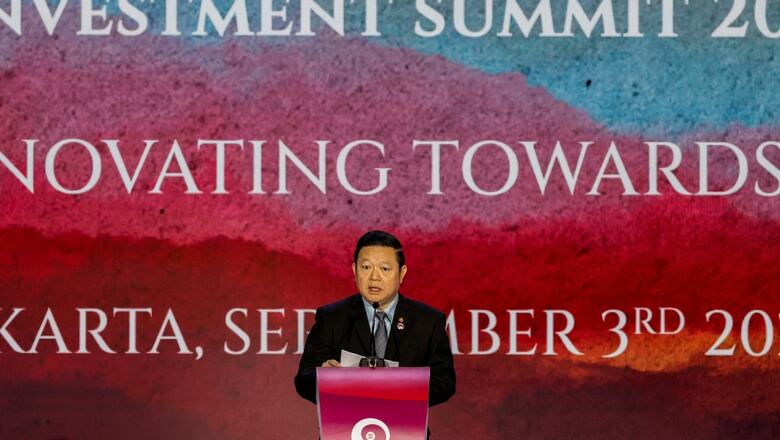
views
In a boost to ASEAN-India relationship the Secretary-General of the Association of Southeast Asian Nations (ASEAN), Dr Kao Kim Hourn, is set to embark on an official five-day visit to India from February 11-15.
Since assuming office in January 2023, Hourn is making his inaugural official trip to India.
During his visit, Dr Hourn will engage in discussions with External Affairs Minister S Jaishankar, and other dignitaries. Additionally, he will deliver a lecture on ‘ASEAN-India Comprehensive Strategic Partnership in Developmental Regional Architecture’ at the Sapru House, organized by the Indian Council of World Affairs (ICWA).
Apart from official engagements, Hourn will tour the UNESCO World Heritage Site of Mahabodhi Temple in Gaya, Bihar. The Ministry has disclosed that he will also speak at Nalanda University in Rajgir on the topic of ‘The Future of ASEAN: Relevance and Flexibility in Emerging Strategic Environment’. ASEAN member country students pursue higher education under ASEAN-India cooperation initiatives at universities, with Nalanda University leading the ASEAN-India Network of Universities (AIUN).
According to the Ministry, India’s engagement with ASEAN remains a vital pillar of its Act East Policy, which marked its 10th year in 2024. This policy underscores India’s commitment to enhancing its strategic partnership with ASEAN nations and deepening regional integration efforts.
Hourn’s visit emphasizes the significance of ASEAN-India relations and highlights the multifaceted cooperation between the two regions across various domains, including education, culture and strategic partnerships. As both India and ASEAN continue to navigate complex geopolitical dynamics, such high-level interactions reinforce mutual understanding and collaboration towards shared goals of regional peace, stability and prosperity.
STRATEGIC COMPREHENSIVE PARTNERSHIP
The basis of Indian interaction and contacts with South East Asia has been shared historic ties, culture and knowledge. The values and culture of India and South East Asia intertwine, stemming from contacts through civilizations. Evidence of these exchanges can be traced back to the 3rd century AD, with historical records indicating trade, Sanskrit, and Indian epics as key mediums. Technical innovations between South East Asia and India are also well-documented. These commonalities form the foundation for synergies between India and the region, encompassing cultural values, structures, language, arts, crafts, architecture and more.
In November 2014, the Government of India (GoI) introduced the Act East Policy at the East Asia and India-Association of Southeast Asian Nations (ASEAN) summit in Myanmar. The policy aims to enhance and expand economic ties in the Asia-Pacific Region while also facilitating political, strategic, and cultural dimensions. Additionally, it seeks to establish institutional mechanisms for dialogue and cooperation. Initially known as the Look East Policy, its primary objective was to stimulate economic development in South East Asian countries. The transition from Look East to Act East Policy reflects a shift towards enhancing both economic and cultural relationships, extending its focus to encompass South East Asia and East Asia.
India has gradually expanded its eastward engagement beyond ASEAN. This shift occurs amid a transition in the regional architecture, where established, open and inclusive regional initiatives, primarily embedded within the ASEAN framework, face challenges from newer, exclusive, and functionally driven initiatives such as the Quad, the Supply-Chain Resilience Initiative, and the AUKUS (Australia-UK-USA) security pact. Simultaneously, India’s Act East Policy (AEP) faces competition from initiatives by other major regional powers, notably China.
The renewed polarization of the international system following the Russian invasion of Ukraine and the emergence of a long-term strategic rivalry between the United States and China has increased pressure on India. In this context, India’s Act East Policy gains more significance.
New Delhi’s eastward engagement has evolved, matured, and deepened during the post-Cold War period. While India may not hold the utmost significance in the region, its regional engagement has progressively gained substance and momentum through the Act East Policy.
The economic partnership between India and ASEAN aims to ensure that the ASEAN-India Comprehensive Strategic Partnership delivers meaningful benefits for both sides, particularly in the post-pandemic era.
Two decades after initiating its ‘Look East’ policy in 1992, India did not see its relationship with regional neighbors mature to the extent originally envisioned. In 2008, annual trade between India and ASEAN was $30 billion, a figure that rose to $80 billion by 2012. In 2022-23, India and ASEAN recorded a bilateral trade of USD 131.5 billion, accounting for 11.3% of India’s global trade during that period.
INDIA-ASEAN ECONOMIC RELATIONSHIP
India and ASEAN boast of a robust economic partnership, with ASEAN ranking among India’s largest trading allies. Conversely, ASEAN holds the position of India’s fourth-largest trading partner, with the financial year (FY) 2021-22 witnessing a total trade value of US$110.4 billion. During this period, India’s exports to ASEAN accounted for US$42.327 billion, while imports from ASEAN totaled US$68.07 billion, marking a significant milestone as bilateral trade exceeded US$100 billion for the first time. In FY 2022-23, bilateral trade volume reached US$131.5 billion, comprising 11.3 per cent of India’s total global trade during the same period.
In August 2023, during the twentieth AEM (ASEAN Economic Ministers)-India Consultation meeting held in Semarang, Indonesia, both ASEAN and India reached a consensus to accelerate negotiations for the revision of their current goods agreement, aiming to finalize discussions by 2025. This review, a long-standing demand of Indian businesses, aims to make the Free Trade Agreement (FTA) more trade-facilitative and mutually beneficial. The ministers agreed to follow a quarterly negotiation schedule, targeting the completion of the review by 2025, expected to enhance trade diversification while addressing current trade imbalances.
Between 2000 and 2021, cumulative Foreign Direct Investments (FDIs) from ASEAN countries into India amounted to US$117.88 billion. Notably, the majority of these investments, totaling US$115 billion, originated from Singaporean investors.
Conversely, Indian investments into ASEAN nations from April 2019 to March 2022 reached US$55.5 billion. Within this figure, a significant portion, specifically US$51.5 billion, was invested in Singapore.
Economic engagements are facilitated and enhanced through three primary formal institutional mechanisms:
ASEAN Economic Ministers-India Consultations (AEM + India): These consultations involve key ASEAN sectoral bodies represented by the ASEAN Economic Ministers (AEM) and typically include participation from the Commerce Minister. Recent AEM-India meetings have focused on reviewing the AITIGA.
The ASEAN India Framework Agreement on Comprehensive Economic Cooperation: This agreement, finalized during the second Summit meeting in 2003, lays the foundation for establishing an ASEAN-India FTA (AIFTA). Under its provisions, several agreements have been concluded, including the AITIGA, in force since January 1, 2010. Additionally, agreements on Trade in Services (AITISA) and Investment were signed in 2014 and ratified by all parties.
ASEAN-India Business Council (AIBC): Established in 2005, the AIBC serves as a pivotal forum for fostering closer business linkages and enhancing economic cooperation between India and ASEAN. AIBC meetings, often coinciding with the ASEAN Business Advisory Council gatherings, create opportunities for Indian business leaders to network with their ASEAN counterparts.
Apart from the joint cooperation in terms of economic integration, India and ASEAN share a deep understanding and relationship in regards to food security.
INDIA-ASEAN FOOD SECURITY
India and ASEAN share a strong commitment to ensuring food security and nutrition in the region, as evidenced by the recent adoption of the ASEAN Leaders’ Declaration on Strengthening Food Security and Nutrition in Response to Crises. This declaration signifies a collective effort to address challenges and promote resilience in the face of crises.
Both India and ASEAN recognize the importance of facilitating the exchange of national policy frameworks, particularly focusing on rice and vital crop commodities. By promoting agricultural diversity and strengthening coordination of food security policies, they aim to enhance food security and nutrition for their populations.
Collaboration in the fields of food security and nutrition is a priority, with focus on promoting trade and investment, capacity building, research and development, technology and innovation, and sustainable management. This comprehensive approach underscores the shared commitment to addressing food security challenges holistically.
Additionally, efforts to support the long-term resilience and sustainability of the agrifood system are underway. This includes strengthening local and regional food value chains, diversifying food sources, and optimizing resource utilization, particularly for small-scale farmers, fishers, and MSMEs.
Moreover, both India and ASEAN are encouraging funding for climate-friendly technologies to promote sustainable agricultural production. Embracing a climate-smart approach is crucial for mitigating the impact of climate change on food security and ensuring a resilient agrifood system.
Efforts to explore best practices in social protection and enhance infrastructure for small and marginal farmers, women, and youth are also underway. By utilizing economic opportunities to promote inclusive agriculture value chains and resilient food systems, India and ASEAN are working towards ensuring that no one is left behind in the journey towards food security and nutrition.
Lastly, the promotion of digital technologies for agricultural transformation, including the interoperability of relevant digital public infrastructure, is a key focus area. Leveraging technology is essential for enhancing efficiency, productivity, and resilience in the agrifood sector.
THE 12-POINT PROPOSAL
During the 20th annual ASEAN-India summit and the 18th East Asia summit held in Jakarta on September 7, 2023, Prime Minister Narendra Modi actively participated and presented a comprehensive 12-point proposal aimed at deepening cooperation between India and ASEAN nations. The move demonstrates India’s commitment to fostering stronger ties with ASEAN economies across various sectors, offering significant opportunities for businesses to expand their footprint in Southeast Asia, improve regional trade and commercial ties, tap into prospects emerging from ongoing digital transformation, and stay relevant in matters concerning geopolitics.
Additionally, the recent ASEAN-India Summit witnessed the adoption of two crucial joint statements, one focusing on Maritime Cooperation and the other addressing Food Security, marking significant developments in the ASEAN-India Comprehensive Strategic Partnership. During the summit, PM Modi engaged in extensive discussions with ASEAN partners, laying the groundwork for the future course of this strategic partnership.
Modi’s 12-point proposal covers a wide range of areas crucial for business and economic engagement, reflecting India’s commitment to fostering robust ties with its ASEAN partners:
- Enhanced connectivity: One of the focal points of the proposal is the establishment of enhanced connectivity, including the creation of a multi-modal connectivity and economic corridor linking Southeast Asia, India, West Asia, and Europe, boosting trade and investment opportunities for businesses in these regions.
- Digital transformation: PM Modi offered to share India’s digital public infrastructure stack with ASEAN partners, facilitating digital transformation across sectors and promoting innovation and efficiency in businesses.
- Digital Future Fund: To strengthen digital cooperation, Modi announced the ASEAN-India Fund for Digital Future, focusing on fostering collaboration in digital transformation and financial connectivity, potentially opening up new avenues for businesses in the digital sector.
- Research support: India pledged renewed support to the Economic and Research Institute of ASEAN and East Asia (ERIA) as a knowledge partner, enhancing research and development opportunities for businesses and promoting informed decision-making.
- Advocating for the Global South: The proposal emphasized the need to collectively raise issues faced by the Global South in multilateral forums, signaling India’s commitment to ensuring the interests of developing nations are heard.
- Traditional medicine center: India invited ASEAN countries to join the Global Centre for Traditional Medicine, established by WHO in India, offering opportunities for cooperation in healthcare, including traditional medicine, a potential growth area for businesses.
- Mission LiFE: PM Modi called for cooperation on Mission LiFE, offering avenues for businesses to contribute to health and environmental sustainability efforts.
- Affordable medicines: India’s offer to share its expertise in providing affordable and quality medicines through Jan-Aushadhi Kendras could benefit businesses in pharmaceutical manufacturing and distribution.
- Counterterrorism cooperation: The proposal called for collective action against terrorism, terror financing, and cyber-disinformation, promoting a secure environment for businesses.
- Disaster resilience: India invited ASEAN countries to join the Coalition for Disaster Resilient Infrastructure, enhancing disaster preparedness and response capabilities, vital for business continuity.
- Disaster management: Cooperation in disaster management can reduce business risks in the face of natural disasters, ensuring smoother operations.
- Maritime security: Enhanced cooperation on maritime safety, security, and domain awareness is vital for businesses engaged in maritime trade and logistics.
INDIA-ASEAN BLUE ECONOMY
The partnership between India and ASEAN continues to prioritize blue economy and maritime cooperation, as outlined in the Joint Statement on ASEAN-India Comprehensive Strategic Partnership adopted in November 2022.
ASEAN defines the Blue Economy as an integrated, holistic, cross-sectoral, and cross-stakeholder approach that adds value to resources from oceans, seas, and fresh water in an inclusive and sustainable manner, serving as a new engine for ASEAN’s future economic growth. The ASEAN Blue Economy encompasses various sectors, acting as an accelerator for traditional marine industries like fisheries, aquaculture, fish processing, and tourism, while also driving emerging sectors such as renewable energy, biotechnology, marine research, freshwater research, and education.
India and ASEAN have acknowledged positive regional developments, including ongoing efforts to establish an ASEAN Network for Combating Illegal, Unreported and Unregulated Fishing, and the adoption of the Bangkok Declaration on Combating Marine Debris and the ASEAN Framework of Action on Marine Debris. At a recent workshop, participants exchanged experiences and ideas on sustainably exploiting marine resources, combating marine debris, promoting coastal and marine tourism, and fostering sustainable maritime connectivity.
INDIA-ASEAN MARITIME RELATIONS
India and ASEAN are forging a robust partnership in maritime cooperation, aiming to enhance safety, security and sustainability in the region’s vast maritime domain. With a shared commitment to safeguarding maritime interests, both sides are intensifying efforts in several key areas.
First and foremost, maritime safety and security take precedence, with a focus on bolstering emergency response capabilities, conducting Humanitarian Assistance and Disaster Relief (HADR) operations, and coordinating Search and Rescue (SAR) efforts. Additionally, concerted action against piracy, armed robbery, trafficking, and smuggling is underway to ensure maritime routes remain safe and secure for all.
Information sharing and capacity building are vital components of this cooperation, with efforts aimed at enhancing collaboration among specialized regional bodies. By pooling resources and expertise, India and ASEAN seek to strengthen maritime capabilities and address emerging challenges effectively.
Furthermore, sustainable maritime practices are at the forefront of collaborative efforts, emphasizing the responsible use of oceans and marine resources. Through engagement with maritime authorities and law enforcement agencies, both sides are exploring sustainable marine-based renewable energy solutions and implementing measures to mitigate climate change impacts and control marine pollution.
Advancing connectivity and promoting the blue economy are overarching goals of India-ASEAN maritime cooperation. Joint initiatives are underway to enhance connectivity across the Indo-Pacific region, facilitating trade, investment and economic development. Additionally, efforts to promote blue economy initiatives, such as marine resource development and environmental conservation, involve active engagement with stakeholders from the private sector, academia, and coastal communities.
CONCLUSION
The ASEAN-India relationship continues to strengthen across various domains, with a particular focus on maritime cooperation and economic partnership. The upcoming official visit of ASEAN Secretary-General Hourn to India underscores the commitment of both sides to deepening bilateral ties and advancing regional cooperation.
Through initiatives aimed at enhancing maritime safety, security, and sustainability, India and ASEAN are working together to address common challenges and promote shared prosperity in the Indo-Pacific region. Their collaborative efforts encompass emergency response, information sharing, capacity building, and the promotion of sustainable maritime practices.
Moreover, the robust economic partnership between India and ASEAN, characterized by growing trade volumes, increased investments, and institutional mechanisms for cooperation, serves as a cornerstone of the bilateral relationship. Both sides are committed to furthering economic integration and enhancing connectivity to unlock new opportunities for trade, investment, and economic growth.
As India celebrates the 10th anniversary of its Act East Policy, Hourn’s visit reaffirms the strategic importance of ASEAN-India relations in advancing regional peace, stability and prosperity. Through continued dialogue, cooperation and mutual understanding, India and ASEAN are poised to navigate the evolving geopolitical landscape and foster a more resilient and interconnected Indo-Pacific community.


















Comments
0 comment